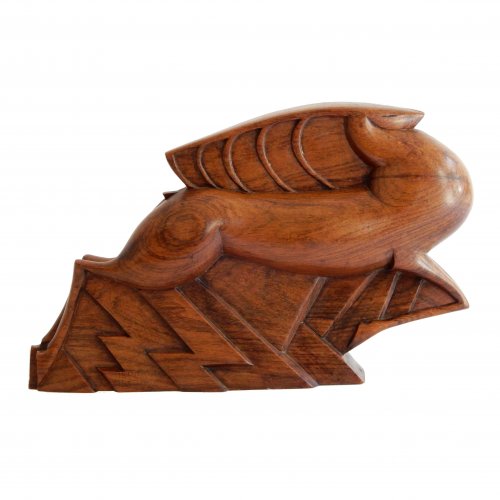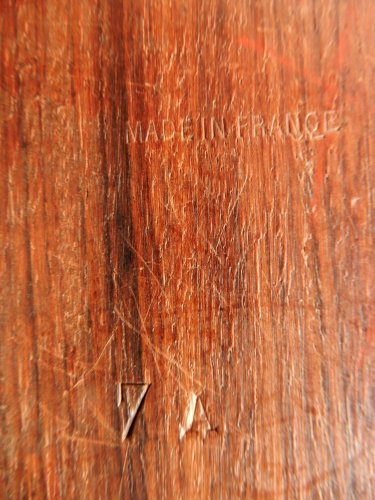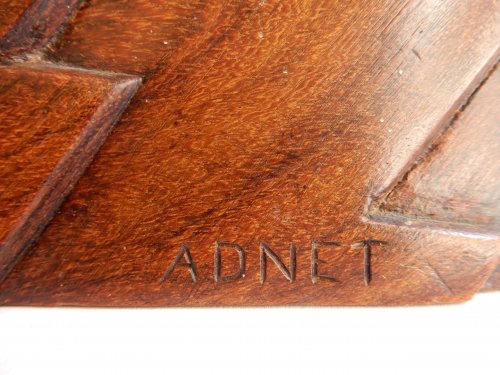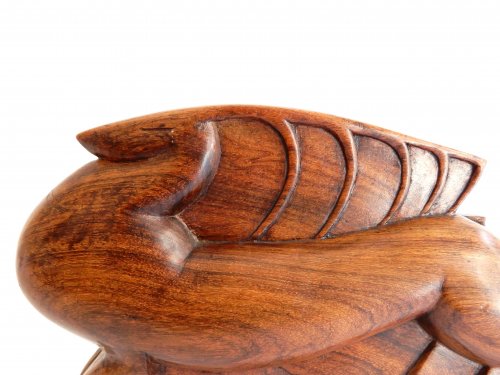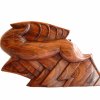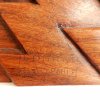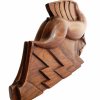jacques Adnet (1900-1984) Antelope
About this piece
This jumping antelope by Jacques Adnet was carved from rosewood and presented at the Salon d'Automne in 1926 and the Salon des Artistes Décorateurs (SAD) in 1927. There is a photograph of an interior by Jean et Jacques Adnet showing the antelope, this photo was taken at the SAD fair in 1927. The sculpture was made by S.A.S. Paris, (Société des Artistes de Salon or as is also believed, Société Anonyme de Sculpture).
This antelope is beautifully stylised with geometric motifs and clearly influenced by Art Deco. The speed and suppleness that the antelope exudes is so beautifully displayed.
Only 4 wooden sculptures are known by Adnet from that period, namely the tango dancers, a female bather, a pigeon and this antelope. They are very rare, as far as we know only a few were made. They are specially made for the Salon. In the mid-1930s there are two other sculptures by him, a cat and a ballerina.
The antelope is extensively signed, on one side with 'Adnet' and on the other side with 'Édition S.A.S. Paris'. On the bottom it says 'Made in France' and the number '7A'.
About Edition S.A.S. Paris:
Edition S.A.S. Paris (Societé des Artistes de Salon) was founded by the artists themselves who attended the Salon des Artistes and had their own work performed in edition. In the late 1920s and early 1930s, these wooden sculptures were exhibited at the Salon and sometimes also in limited editions for clients such as DIM (Decoration Interieure Moderne).
Artists such as Adnet, Sandoz, Privat, the Canto de Maya and also the Martel brothers were all part of Éditions S.A.S. Paris.
Biography:
Jack Édouard Jules Adnet, better known as Jacques Adnet (Châtillon-Coligny, 1900 - Paris, 1984), is a French architect, decorator and interior designer. Together with his twin brother Jean Adnet (1900-1995), he studied applied art in Auxerre. After graduating, he worked together with Maurice Dufrène and Tony Selmersheim. When Maurice Dufrène was appointed director of 'La Matrise', the art studio of Galeries Lafayette, Jacques and Jean Adnet followed suit.
In 1925, during the famous Exposition Internationale des Arts Décoratifs et Industriels modern, the brothers were allowed to exhibit their ceramics in the booth of La Matrise. Their joint designs were signed with J.J. adnet. There was also a lot of interest in the two brothers at the Salon d'Automne. Until 1928, the two brothers continued to work together, making furniture and applied art objects in a characteristic Art Deco style. But they also designed separately from each other. This antelope is a design by Jacques Adnet. In 1927 Jacques Adnet won the prestigious Blumenthal Grand Prix.
Their collaboration ended when Jacques took over the management of the Compagnie des Arts Français, which had been founded in 1919 by Louis Sue et André Mare. Jean Adnet continued to work at Galeries Lafayette as exhibition director.
Jacques remained director and chief designer of the Compagnie des Arts Francaise until 1959, his motto was "Evolution in tradition".
He was a modernist, like his designs, which are increasingly streamlined and simplified, reduced to the essentials. He believes that technology should follow inspiration and not precede it. He wants not only to put the usefulness of the object first but also to please the soul and the eye.
Jacques Adnet gathers around him artists in all kinds of disciplines, such as
glassware, jewellery, goldsmiths, ironwork, sculpture, copper ware, tapestry, fine arts and so on.
He collaborates with Francis Jourdain, Charlotte Perriand, Raoul Dufy, Alexandre Noll, Serge Mouille and Georges Jouve, Jean Besnard, Claudius Linossier and later also Alberto Giacometti and Diego Giacometti.
He also creates personal works and is one of the first to use metal and glass together for lighting or furniture. He likes chrome-plated, nickel-plated metal, mirrors, glass, wood, often black lacquered and crystal. His work is functional and modernistic, free of ornaments, modern lines with luxurious materials. He also shows bare light bulbs in subtle metal frames, which were really something new at the time.
Jacques Adnet was commissioned to design and furnish the house of actress Alice Cocea, French President Vincent Auriol's study at the Chateau of Rambouillet in 1947, his apartment at the Palais de l'Elysée and luxury ocean liners such as 'Ile de France'. ', the Unesco building and many other assignments, he also worked for Hermès for several years. He was an icon of luxury French modernism, famous and respected as a designer and interior architect.
He retired from the Compagnie des Arts Française in 1959 and became director of the École Nationale Supérieure des Arts Decoratifs until 1971.
Jacques Adnet died on October 29, 1984 in Paris.
His work can be found in many museum collections worldwide, including the Musée Boulogne-Billancourt and the Musée des Arts Décoratifs in Paris.
Literature and sources:
- Alain-Renee Hardy and Gaelle Millet; "Jacques Adnet", Editions de l'Amateur, 2009. P.236 with photo.
- Yvonne Brunhammer and Suzanne Tise; "French Decorative Art, the Société des Artistes Décorateurs 1900-1942", Flammarion, Paris 1990. P. 147, with interior photo with antelope on the SAD, 1927.
- Archives of Musée des Arts Décoratifs in Paris.
- Ben Weaver; 'Jacques Adnet', The London List. (Article)
- Wikipedia French
Condition
Good condition, an old crack is once professionally restored.
Material:
rosewood
Measurements:
Length: 37 cm
(14,57")
Height: 24,5 cm
(9,65")
Year:
approximately 1926
Origin:
France
Artist / atelier:
jacques Adnet,

